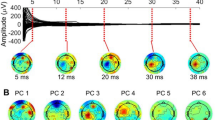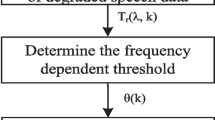Abstract
Blind source extraction (BSE) is widely used to solve signal mixture problems where there are only a few desired signals. To improve signal extraction performance and expand its application, we develop an adaptive BSE algorithm with an additive noise model. We first present an improved normalized kurtosis as an objective function, which caters for the effect of noise. By combining the objective function and Lagrange multiplier method, we further propose a robust algorithm that can extract the desired signal as the first output signal. Simulations on both synthetic and real biomedical signals demonstrate that such combination improves the extraction performance and has better robustness to the estimation error of normalized kurtosis value in the presence of noise.
Similar content being viewed by others
References
Hyvärinen A, Karhunen J, Oja E. Independent Component Analysis. New York: Wiley, 2001
Cichocki A, Amari S. Adaptive Blind Signal and Image Processing. New York: Wiley, 2003
Santana E, Principe J C, Santana E E. Extraction of signals with specific temporal structure using kernel methods. IEEE Transactions on Signal Processing, 2010, 58(10): 5142–5150
James C J, Hesse C W. Independent component analysis for biomedical signals. Physiological Measurement, 2005, 26(1): 15–39
Barros A K, Cichocki A. Extraction of specific signals with temporal structure. Neural Computation, 2001, 13(9): 1995–2003
Lu W, Rajapakse J C. ICA with reference. Neurocomputing, 2006, 69(16–18): 2244–2257
Lu W, Rajapakse J C. Approach and applications of constrained ICA. IEEE Transactions on Neural Networks, 2005, 16(1): 203–212
Huang D S, Mi J X. A new constrained independent component analysis method. IEEE Transactions on Neural Networks, 2007, 18(5): 1532–1535
Li C L, Liao G S, Shen Y L. An improved method for independent component analysis with reference. Digital Signal Processing, 2010, 20(2): 575–580
Zhang Z L. Morphologically constrained ICA for extracting weak temporally correlated signals. Neurocomputing, 2008, 71(7–9): 1669–1679
Zhang Z L, Zhang Y. Extraction of a source signal whose kurtosis value lies in a specific range. Neurocomputing, 2006, 69(7–9): 900–904
Leong W Y, Mandic D P. Noisy component extraction (NoiCE). IEEE Transactions on Circuits and Systems, 2010, 57(3): 664–671
Liu W, Mandic D P. A normalized kurtosis-based algorithm for blind source extraction from noisy measurements. Signal Processing, 2006, 86(7): 1580–1585
Liu W, Mandic D P, Cichocki A. Blind second-order source extraction of instantaneous noisy mixtures. IEEE Transactions on Circuits and Systems, 2006, 53(9): 931–935
Hyvärinen A. Gaussian moments for noisy independent component analysis. IEEE Signal Processing Letters, 1999, 6(6): 145–147
Cichocki A, Amari S, Siwek K, Tanaka T, Phan A H. ICALAB Toolboxes. http://www.bsp.brain.riken.jp/ICALAB
Cichocki A, Thawonmas R, Amari S. Sequential blind signal extraction in order specified by stochastic properties. Electronics Letters, 1997, 33(1): 64–65
Belouchrani A, Abed-Meraim K, Cardoso J F. A blind source separation technique using second-order statistics. IEEE Transactions on Signal Processing, 1997, 45(2): 434–444
De Moor D. Daisy: database for identification of systems. http://www.esat.kuleuven.ac.be/sista/daisy
Author information
Authors and Affiliations
Corresponding author
Additional information
Yongjian Zhao received his BEng degree from East China University of Science and Technology, China, in 1991, and his MSc degree in Computer Science from Shandong University, China, in 2003. He is currently a PhD candidate in the Department of Biomedical Engineering, Shandong University, China. He is also an associate professor of Department of Computer Science, Shandong University at Weihai, China. He is author or coauthor of 16 research publications in refereed journals, conference proceedings, and books. His research interests include biomedical signal processing, blind source separation, and pattern recognition.
Boqiang Liu received his PhD in Biomedical Engineering from Tianjin University, China, in 2005. Now he is a professor and PhD supervisor at Shandong University. His current research interests include biomedical signal processing, image processing, and pattern recognition.
Sen Wang received his PhD in Computer Science from Stony Brook University, New York, USA in 2008. He currently is a senior research scientist in Kodak Research Laboratories, Eastman Kodak Company. His main interests are computer vision, computer graphics, stereo/3D imaging, biometrics, image/video processing and human computer interaction. He has more than 20 research papers and 30 patent applications in the above areas.
Rights and permissions
About this article
Cite this article
Zhao, Y., Liu, B. & Wang, S. A robust extraction algorithm for biomedical signals from noisy mixtures. Front. Comput. Sci. China 5, 387–394 (2011). https://doi.org/10.1007/s11704-011-1043-5
Received:
Accepted:
Published:
Issue Date:
DOI: https://doi.org/10.1007/s11704-011-1043-5




